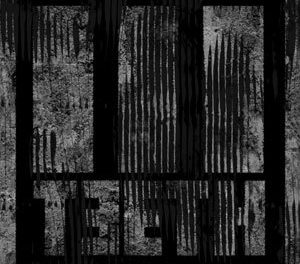High-Functioning Flesh
Definite Structures
Dais Records
Bruce: It’s been interesting to watch how the new wave of industrial acts from California (we still need a catchy name, self-applied or otherwise) have handled follow-ups to well received releases. The likes of Youth Code and ∆AIMON have built on past success and opened up new doors, and now the thirsty ear of the archetypal industrial listener turns to Susan Subtract and Greg Vand of High-Functioning Flesh (you’re on deck, 3 Teeth). Our Thing certainly doesn’t come with the stress that fresh and guileless major label signees famously experience when they head to the studio to repeat and improve upon past success, but I can’t help but be interested by the variety of responses felt and approaches taken by these bands when they sign up for another tour of duty.
Anyway, I want to say that Definite Structures comes as a shock, but that implies having defined expectations about how their sophomore record would distinguish itself from its predecessor, A Misery of Unities – A Unity of Miseries, and to be honest, I was hedging my bets. Yes, tunes like “Flash Memory” and “Self-Management” had a rigor and rage unseen on their demo tape, but the band still felt like an open enough project that it could careen off in several different directions. Without wanting to put ourselves over, we noted a slight uptick in the role pop and funk played in the band on A Misery of Unities – A Unity of Miseries, but I don’t think something as florid and developed as nearly each of the tunes on Definite Structures was what we had in mind. What were your initial reactions to it?
Alex: It’s a wonderfully new and different record for sure, and the differences between it and Misery of Unities are especially pronounced considering how little time there was between them. Like you alluded to, this album really strikes out into a more funky post-industrial territory that has a lot more in common with Severed Heads or mid-period Cabs than anything they’ve released previously. It almost feels like a disservice to HFF to toss those names off lightly, since I think they’ve been especially plagued by lazy comparisons to Ebb and others, but folks need to understand: if you had High-Functioning Flesh slotted as a neo-oldschool EBM band, ya’ll need to reassess because they’ve really broken out of that frame on this record (if they were ever really in it to begin with).
So yeah, I’m not gonna be coy, I love this god damn record. The pump was primed for it but even so, coming through with a level-up of this magnitude isn’t something that commonly happens. We obviously were pretty into the last album, but I think we’ve become so used to being able to sort of predict what a record will sound like based on previews and videos and snippets on Soundcloud and whatnot that actually surprising us this way is kind of difficult. Even hearing “Confuse the Call” on that DKA compilation Strategies Against the Body didn’t tip their hand to me. So to finally answer your question, I guess my first impression of Definite Structures wasn’t so much astonishment at any change in style, but genuine surprise at exactly how accomplished and just plain listenable it is.
Bruce: You ain’t kidding on listenability. I put this on loop on the weekend while doing some housework and gaming, and found that I just didn’t get tired of the bounce and groove that kept flowing through the apartment. I later found out it had played through a full eleven times, which has to be a personal record, at least since self-reversing cassettes ceased to be my bread and butter.
I wonder if that sort of enjoyment and ease is something we’ve been subconsciously reacting against over the past ten or so years. Futurepop lived and died by its anthemic appeal and cribbing of massively popular and mainstream trance motifs. In trying to move beyond that to find a new revival of industrial, I think the ease of listening futurepop could offer is something we’ve all too often thrown out with the bathwater. That isn’t to say that Definite Structures gives me anything like a futurepop feel; just the opposite. We recently had a discussion on the podcast about how dated attempts to get on the radio via the so-called loudness war now seem. I wonder if attempts at club dominance through big and immediate 4-4 tracks over the past decade or so (in futurepop, aggrotech, or perhaps even newer techno-hybrid sounds) will one day be looked at as similarly facile. When I say that Definite Structures is easy to listen to and repeatedly engage with, I don’t mean that that’s part of a stilted attempt at club accessibility or crossover appeal; it just means that High-Functioning Flesh have shown themselves to have an ear for harmony, melody, and swing which their extant work hadn’t really hinted at yet which comes across as being completely easy and natural. The sort of aggression which first endeared them to us is still here on “Afterbirth” and “Whispered Steel”, it’s just heavily augmented. Susan hasn’t really changed his starved bark and gasp, he’s just found ways of channelling it to run parallel to melody (as on my personal fave “Mistakes Were Made”).
We’re definitely in agreement on the Severed Heads and Cabs notes. I feel like those bands stick out as flags not because this record sounds slavishly like theirs, but because those bands’ abilities to integrate funk, mutant-pop, and rhythmic sampling is part of industrial history we very rarely see being picked up on. Why do you think that is?
Alex: I’d hazard a guess that a lot of what we think of as the global umbrella industrial scene kind of forgot about how funky the genre was in its second wave period (or never knew to begin with). Maybe it’s due to some perceived incompatibility between TRU DARK RIVETZ and music you can groove to, but regardless I don’t get the impression High-Functioning Flesh much care what’s been hitting in goth clubs for the last couple decades.
Which leads us to one of the things most striking about Definite Structures: there’s nothing I would specifically call “dark” on the album (okay, maybe “Grey Scent” a little, but that song is more pensive than bleak IMO). There’s some aggression as you noted earlier, but instrumentally there’s a bright, clear quality to the recording which I find really adds to the replayability factor. I love how it opens on “Hunger Cries” which is filled with all these chiming synth bell sounds and has this very uplifting lyrical turn in it with Susan intoning “my heart is mine, so take your time”. I get the same thing from “Mistakes Were Made” and “Whispered Steel”, which both have these sprightly chirping leads that really work well for me. The latter song also has this awesome call/response vocal breakdown in it that always takes a bit by surprise but I love because it feels so unique and unlike anything you hear on genre records. It’s just a different mood and a different execution than what I’m accustomed to hearing in stylistically similar albums.
Also, man am I into how much vocal sampling this record has on it. I mean it’s always been a major part of their sound, but never as a focus, more for it’s rhythmic quality than anything else. I couldn’t tell you what any single pitched down human voice sample is saying on this album (except for the “like a human being” sample on “Confuse the Call”, but I’ve listened to that song *a lot* of times), but there’s something in how our ears perceive the timbre of human speech that makes it stick out in the mix even when the words themselves aren’t decipherable. HFF aren’t the first band to strike on how you can use that sort of psychoacoustic trick grab the listener’s ear, but they’re the best practitioners I can think of in recent memory. Any thoughts on that particular bag of tricks and how Definite Structures makes use of them?
Bruce: Well, the sort of manipulation of samples HFF uses always speaks to early tape-based manipulation and looping of samples, stressing, as you say, timbre over content. I think there’s something very originally industrial at the core of that. If the idea of TG and other early artists was that the detritus and by-products of the industrial age should be the grist for the mill of new art, then surely our churning media has to be part of that. Hell, in an age in which the majority of traditional industrial and manufacturing jobs have so long ago departed this continent that barely anyone our age or younger ever entertained them as employment opportunities, talking heads are maybe the only thing we’re actually producing.
Media cut-ups and loops have been part of industrial culture since the very beginning, of course: see the old story about Burroughs teaching Gen about magick via the then-brand new technology of the remote control. But I do think there’s a connection between that media manipulation and the bubbly, lighter sides of the record we’ve already talked about. This sort of manipulation goes hand in hand with “play” in the broadest sense of the word. Engage with, manipulate, sample, recreate. Hell, think of “funk” in its original sense as a transitive verb: take this established rhythm or song and funk it up. This sort of work doesn’t have to feel like work qua work, as HFF show: it’s about the pleasure of slipped meanings, reveling in the interzone (we’re quite a ways from “Stiff Dance” here). It also seems appropriate that the only sample I could definitively recognize comes from Repo Man, surely one of the most definitively California movies ever made and definitely in keeping with surfing through an autophagous economy; as with sampling, the only labour which can yield results in an economically and artistically bankrupt age is retaking that which previous owners no longer have a claim to.
Anyway, enough cod media analysis. Your final thoughts on the record and how it changes or shape’s HFF’s place in the current industrial topos?
Alex: Welp, like I said off the top, I think this record should firmly break HFF free from the shackles of the retro-EBM tag. They’re an act with electronic body music in their sound and with some warm 80s styles in their production, but this is way more than that in that more-than-the-sum-of-its-parts way. This doesn’t feel like a revival or an homage record to me. It has too much verve, too much energy, too many hooks, creative swerves, and clever bits of execution (I feel like I could write a whole article just enumerating all the neat choices they make on “Confuse the Call” and arguably it’s not even the best song here) for those tags.
I like to think that Definite Structures speaks to how open the stylistic borders have become over the last couple years. This is an industrial record, sure, but it also nods to the legacy of Los Angeles’ weird mutant punk scene, and to some really bigger ideas about the music of those traditions and how they can make up really good new art. And it manages those things by being really open and accessible and free from a lot of the trappings that I think ghettoize genre music. The unassuming photo of Susan and Greg on the album cover is the perfect statement about the album’s contents: High-Functioning Flesh present themselves exactly as they are, and the result is just stellar. Album of the year contender for sure.







The question is – who’s preventing the Bandcamp release? Dais? So lame.
It was a choice HFF had to make. We’re ultimately really happy that the record is available literally everywhere else in a digital format thanks to the digital licensing group us and Dais went with. Trust that if you buy the record on Amazon or wherever, we will receive the much appreciated compensation.
Why should there be a catchy name for the new wave of California bands? Do Youth Code, ∆aimon, High Functioning Flesh, and 3 Teeth have much in common beyond their geographic origin?
For ease of reference.
Can you picture yourself reviewing some new band in 2026 that isn’t even from California, and thinking, “This is definitely influenced by that mid-2010s California industrial sound… not any band in particular, but they definitely have that sound of mid-2010s California industrial”?
If someone wrote that in a review now, I’d have no idea what kind of sound to expect. But I’d love to be wrong about that, because I imagine your explanation of what unites those bands as a movement is really smart and insightful.
I think one thing they have in common besides geography (which is no small thing…musical innovations usually come out of scenes) is how they build their signature sounds from the foundation of Wax Trax/European body music of the late 80s and early 90s. (Perhaps throw them Are Us Too in there as well and call Dais the new Wax Trax)
I’m afraid I’m not quite up to snuff on my history… what temporal/spatial/conceptual span does the “second wave period” you mentioned refer to? I know Cabaret Voltaire were pretty damn funky starting at least by 83 or 84.
Loosely, I think of second wave as the early to mid eighties period.
ok, thanks Susan. I found Flac on Boomkat. I hate being so negative but omitting Bandcamp is a bad move, and neither you nor the label have publicised (that I have seen) Boomkat or the availabity of lossless downloads. The thought of paying for a lossy download is fairly hilarious. Just food for thought! haha
When I think of California I think of Avocados…